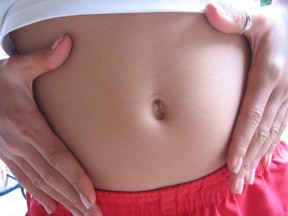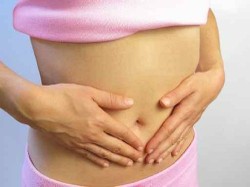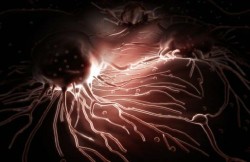In the intestine the altered food, or chyme, comes under the influences of secretions derived from the liver, the pancreas, and the intestine.
The pancreatic juice is poured a long with the bile into the duodenum. It is an alkaline fluid and contains ferments which act on the proteins, fats, and carbohydrates.
The protein ferment, "trypsin," only acts in an alkaline fluid and is a more powerful ferment than pepsin. It splits the proteins into their most absorbable form, i.e. amino-acids. The starch ferment, "amylopsin", has the power of converting starch into sugar after the manner of ptyalin.
The lipolytic or fat-splitting ferment breaks up the fat into fatty acids and glycerine; the fatty acids combine with the alkali to form soaps which are soluble and easily absorbed. The digestion of fats is augmented by the biliary secretion.
Bile, by reducing the surface tension between fat and water, promotes the fine emulsification of fat and facilitates the action of the ferment; it also helps to dissolve the soaps. On absorption by the epithelial cells of the intestine, the fatty acid and glycerine are resynthetised. The fat is taken up by the lymphatics of the intestinal mesentery: it gives them a milky appearance, and they are known as lacteals.
These fine channels eventually join the main lymphatic vessel, the thoracic duct, which opens into the large vein leading into the right side of the heart. Thus the absorbed fat or chyle reaches the blood-stream indirectly via the thoracic duct.
The secretory activities of the pancreatic and liver glands are occasioned by the chemical stimulus of a substance produced by the action of acid on the duodenal mucous membrane. This product is known as "secretin," and it belongs to the group of "chemical messengers" or "hormones" which are absorbed directly into the blood-stream and produce their effects on remote organs of the body.
The completion of the chemical digestive process is effected by the intestinal juice. This secretion is produced by tubular glands occurring in the mucous membrane of the small intestine. "Secretin" is the stimulus for its production.
The intestinal juice is an alkaline fluid containing a number of ferments.
"Maltose" completes the digestion of starch into sugar; "invertase" and "lactase" convert complex sugars into simple ones; "erepsin " acts on partially digested proteins and reduces them to amino-acids.
It will be noted that the terminal result of the action of the digestive juices on food-stuffs is their conversion into amino-acids, simple sugars (glucose), fatty acids, soap, and glycerine. Each stage of the process is correlated with and is dependent on the preceding stage.
The small intestine, with its ridged mucous membrane and "villi," plays the most important part in the process of absorption. Each villus is covered with an epithelium which has a special selective function and is able to transmit products of digestion to the central lacteals or capillary blood-vessels which form the core of the villus.
While digestion is proceeding the intestinal contents arc slowly propelled along the gut towards the colon. At the same time these contents are subjected to a continuous mixing process. The onward movement is caused by progressive waves of muscular contraction and constitutes "peristalsis" ; the mixing action is produced by separate segmental or ring-like contractions. These movements can be observed in human beings by means of the X-rays after the administration of a bismuth meal.
The muscle of the small intestine is controlled by fibers from the vagus and the sympathetic nervous system; hence the influence of mental states on the bowels. Pain and anger may inhibit their activity; anxiety and fear cause exaggeration.
About five hours after a meal the contents of the small intestine commence to pass into the large intestine. These contents are devoid of nutritional material and consist mainly of indigestible residue with waste substances excreted from the liver and intestinal walls. The large intestine is relatively short and its function is to reduce the bulk of the food residue by the absorption of water.
Bacterial decomposition also takes place there; putrefaction and fermentation occur with the formation of gases.
The residues are slowly propelled along the colon; gradually become semi-solid and constitute the feces. These are retained for some time in the colon until, usually after a meal, a certain quantity passes into the rectum. This gives rise to the desire for defecation, and, by relaxation of the sphincter of the anus accompanied by contraction of the walls of the rectum aided by voluntary contraction of abdominal muscles, the contents of the rectum are evacuated.
In the child defecation is a pure reflex; in the adult it is under voluntary control.


 The process of digestion commences when food is taken into the mouth. Saliva is immediately secreted and is poured into the mouth in considerable quantities. It is intimately mixed with the food which is ground up and chewed into a pulpy mass by the teeth, aided by the muscular movements of the cheeks, lips, and tongue.
The process of digestion commences when food is taken into the mouth. Saliva is immediately secreted and is poured into the mouth in considerable quantities. It is intimately mixed with the food which is ground up and chewed into a pulpy mass by the teeth, aided by the muscular movements of the cheeks, lips, and tongue.





 Your rash and itching problems may be Scabieson 03/10/2013
Your rash and itching problems may be Scabieson 03/10/2013
 Tickson 11/06/2011
Tickson 11/06/2011
 Vitamin Kon 10/10/2011
Vitamin Kon 10/10/2011
 Vitamin Eon 10/10/2011
Vitamin Eon 10/10/2011




Comments